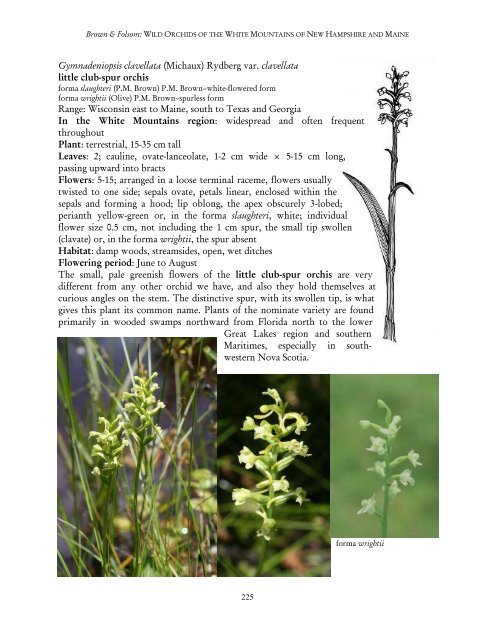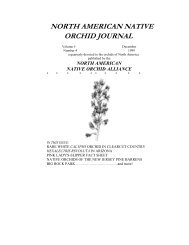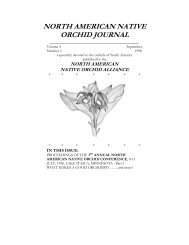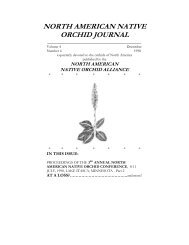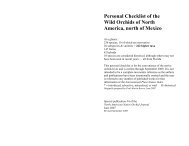north american native orchid journal - at The Culture Sheet
north american native orchid journal - at The Culture Sheet
north american native orchid journal - at The Culture Sheet
Create successful ePaper yourself
Turn your PDF publications into a flip-book with our unique Google optimized e-Paper software.
Brown & Folsom: WILD ORCHIDS OF THE WHITE MOUNTAINS OF NEW HAMPSHIRE AND MAINE<br />
Gymnadeniopsis clavell<strong>at</strong>a (Michaux) Rydberg var. clavell<strong>at</strong>a<br />
little club-spur orchis<br />
forma slaughteri (P.M. Brown) P.M. Brown–white-flowered form<br />
forma wrightii (Olive) P.M. Brown–spurless form<br />
Range: Wisconsin east to Maine, south to Texas and Georgia<br />
In the White Mountains region: widespread and often frequent<br />
throughout<br />
Plant: terrestrial, 15-35 cm tall<br />
Leaves: 2; cauline, ov<strong>at</strong>e-lanceol<strong>at</strong>e, 1-2 cm wide × 5-15 cm long,<br />
passing upward into bracts<br />
Flowers: 5-15; arranged in a loose terminal raceme, flowers usually<br />
twisted to one side; sepals ov<strong>at</strong>e, petals linear, enclosed within the<br />
sepals and forming a hood; lip oblong, the apex obscurely 3-lobed;<br />
perianth yellow-green or, in the forma slaughteri, white; individual<br />
flower size 0.5 cm, not including the 1 cm spur, the small tip swollen<br />
(clav<strong>at</strong>e) or, in the forma wrightii, the spur absent<br />
Habit<strong>at</strong>: damp woods, streamsides, open, wet ditches<br />
Flowering period: June to August<br />
<strong>The</strong> small, pale greenish flowers of the little club-spur orchis are very<br />
different from any other <strong>orchid</strong> we have, and also they hold themselves <strong>at</strong><br />
curious angles on the stem. <strong>The</strong> distinctive spur, with its swollen tip, is wh<strong>at</strong><br />
gives this plant its common name. Plants of the nomin<strong>at</strong>e variety are found<br />
primarily in wooded swamps <strong>north</strong>ward from Florida <strong>north</strong> to the lower<br />
Gre<strong>at</strong> Lakes region and southern<br />
Maritimes, especially in southwestern<br />
Nova Scotia.<br />
225<br />
forma wrightii


